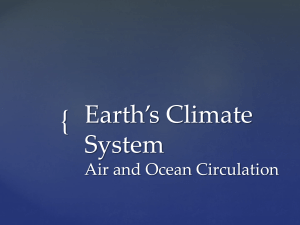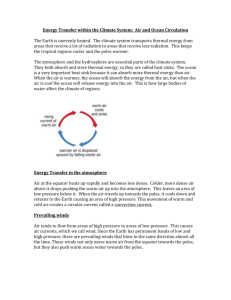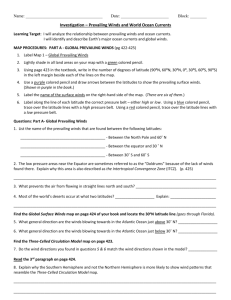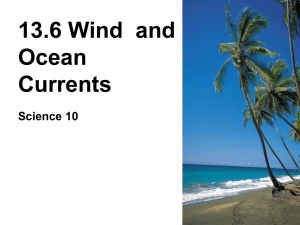Winds & Ocean Currents
advertisement
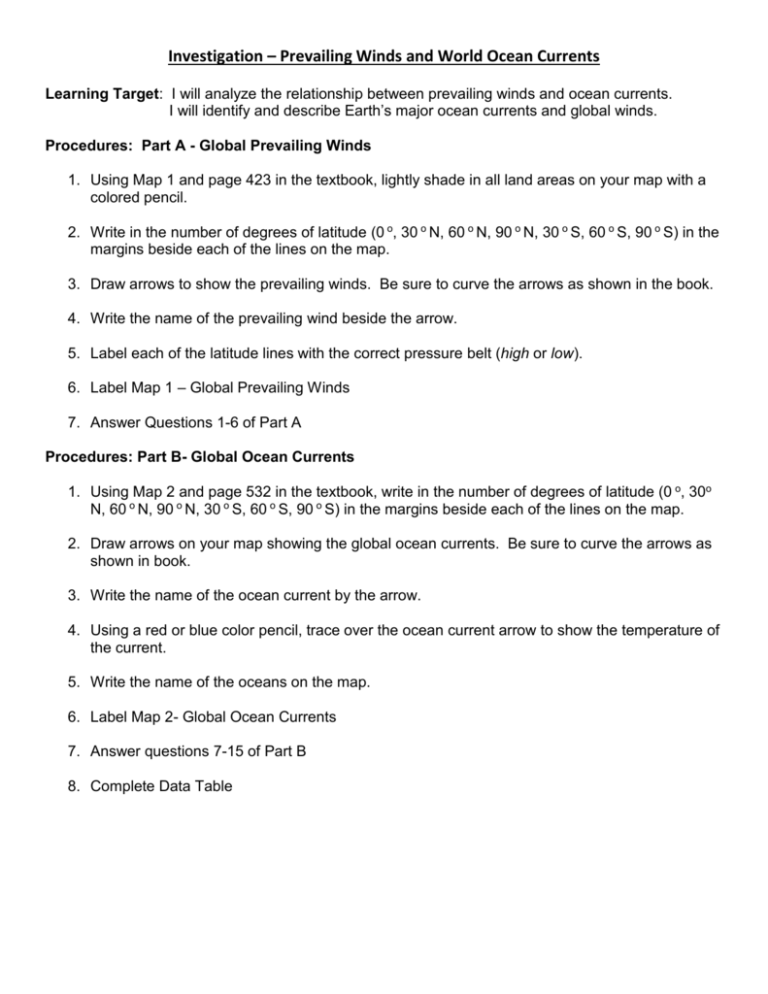
Investigation – Prevailing Winds and World Ocean Currents Learning Target: I will analyze the relationship between prevailing winds and ocean currents. I will identify and describe Earth’s major ocean currents and global winds. Procedures: Part A - Global Prevailing Winds 1. Using Map 1 and page 423 in the textbook, lightly shade in all land areas on your map with a colored pencil. 2. Write in the number of degrees of latitude (0 o, 30 o N, 60 o N, 90 o N, 30 o S, 60 o S, 90 o S) in the margins beside each of the lines on the map. 3. Draw arrows to show the prevailing winds. Be sure to curve the arrows as shown in the book. 4. Write the name of the prevailing wind beside the arrow. 5. Label each of the latitude lines with the correct pressure belt (high or low). 6. Label Map 1 – Global Prevailing Winds 7. Answer Questions 1-6 of Part A Procedures: Part B- Global Ocean Currents 1. Using Map 2 and page 532 in the textbook, write in the number of degrees of latitude (0 o, 30o N, 60 o N, 90 o N, 30 o S, 60 o S, 90 o S) in the margins beside each of the lines on the map. 2. Draw arrows on your map showing the global ocean currents. Be sure to curve the arrows as shown in book. 3. Write the name of the ocean current by the arrow. 4. Using a red or blue color pencil, trace over the ocean current arrow to show the temperature of the current. 5. Write the name of the oceans on the map. 6. Label Map 2- Global Ocean Currents 7. Answer questions 7-15 of Part B 8. Complete Data Table Name _______________________________________ Date _____________________ Block ______ Prevailing Winds & World Ocean Currents PART A – GLOBAL PREVAILING WINDS: 1. List the name of the prevailing winds that are found at the following latitudes: ____________________________ - Between the North Pole and 60˚ N ____________________________ - Between the equator and 30 ˚ N ____________________________ - Between 30˚ S and 60˚ S 2. Why are the horse latitudes (30˚ N and 30˚ S) known as divergence zones? (think about the motion of the winds there) _________________________________________________________________________________________________ Find the Global Surface Winds map on page 424 of your book & locate 30˚ N 3. What direction are the winds blowing in the Atlantic Ocean just above 30˚ N? ________________________________ 4. What direction are the winds blowing in the Atlantic Ocean just below 30˚ N? ________________________________ Find the Three-Celled Circulation Model map on page 423. 5. Do the wind directions found in question 3 above agree with the model? _____________________________________ Read the 3rd paragraph on page 424. 6. Explain why the Southern Hemisphere is more likely to have wind patterns that resemble the Three-Celled Circulation Model map. _________________________________________________________________________________________________ PART B – GLOBAL OCEAN CURRENTS: 7. What is the relationship between the temperature of an ocean current and the direction of current flow from the equator? Explain why this relationship exists. _________________________________________________________________________________________________ _________________________________________________________________________________________________ 8. What is the relationship between a current’s temperature and the side of the ocean (east / west) on which that current flows? _________________________________________________________________________________________________ _________________________________________________________________________________________________ 9. What is the general temperature & direction of currents that flow along the east coast of a continent? _________________________________________________________________________________________________ 10. What is the general temperature & direction of currents that flow along the west coast of a continent? ________________________________________________________________________________________________ 11. What direction do the major circulation patterns rotate in the Northern Hemisphere? [clockwise or counterclockwise] 12. What direction do the major circulation patterns rotate in the Southern Hemisphere? [clockwise or counterclockwise] 13. Why does each hemisphere have a different pattern? __________________________________________________ 14. Which prevailing winds are most likely responsible for driving the West Wind Drift? ___________________________ 15. Why does this current travel in nearly a straight path around Earth? _________________________________________________________________________________________________ Use your maps and textbook, pages 423 and 532, to complete the data table below. OCEAN CURRENTS DATA TABLE Name of current Gulf Stream Brazil Kuroshio E. Australia Agulhas W. Australia Benguela Canary Peru California Ocean Basin (Atlantic/Pacific/Indian) Prevailing Wind (east/west) General Temperature (warm/cold) Flow Direction Relative to Equator (toward/away from)


